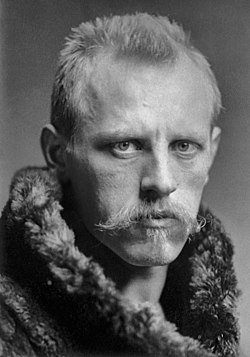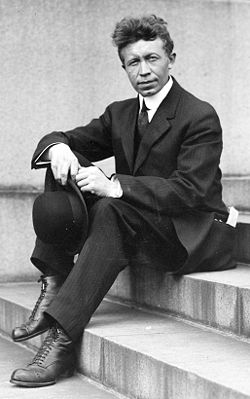User:Godsy/Portal example
Portal maintenance status: (February 2019)
|
Introduction
Polar exploration is the process of exploration of the polar regions of Earth – the Arctic region and Antarctica – particularly with the goal of reaching the North Pole and South Pole, respectively. Historically, this was accomplished by explorers making often arduous travels on foot or by sled in these regions, known as a polar expedition. More recently, exploration has been accomplished with technology, particularly with satellite imagery.
From 600 BC to 300 BC, Greek philosophers theorized that the planet was a Spherical Earth with North and South polar regions. By 150 AD, Ptolemy published Geographia, which notes a hypothetical Terra Australis Incognita. However, due to harsh weather conditions, the poles themselves would not be reached for centuries after that. When they finally were reached, the achievement was realized only a few years apart. (Full article...)
Selected general articles
-
Image 1
Sir Ernest Henry Shackleton (15 February 1874 – 5 January 1922) was an Anglo-Irish Antarctic explorer who led three British expeditions to the Antarctic. He was one of the principal figures of the period known as the Heroic Age of Antarctic Exploration.
Born in Kilkea, County Kildare, Ireland, Shackleton and his Anglo-Irish family moved to Sydenham in suburban south London when he was ten. Shackleton's first experience of the polar regions was as third officer on Captain Robert Falcon Scott's Discovery Expedition of 1901–1904, from which he was sent home early on health grounds, after he and his companions Scott and Edward Adrian Wilson set a new southern record by marching to latitude 82° S. During the Nimrod Expedition of 1907–1909, he and three companions established a new record Farthest South latitude of 88°23′ S, only 97 geographical miles (112 statute miles or 180 kilometres) from the South Pole, the largest advance to the pole in exploration history. Also, members of his team climbed Mount Erebus, the most active Antarctic volcano. On returning home, Shackleton was knighted for his achievements by King Edward VII. (Full article...) -
Image 2
Fridtjof Wedel-Jarlsberg Nansen (Norwegian: [ˈfrɪ̂tːjɔf ˈnɑ̀nsn̩]; 10 October 1861 – 13 May 1930) was a Norwegian polymath and Nobel Peace Prize laureate. He gained prominence at various points in his life as an explorer, scientist, diplomat, humanitarian and co-founded the Fatherland League.
He led the team that made the first crossing of the Greenland interior in 1888, traversing the island on cross-country skis. He won international fame after reaching a record northern latitude of 86°14′ during his Fram expedition of 1893–1896. Although he retired from exploration after his return to Norway, his techniques of polar travel and his innovations in equipment and clothing influenced a generation of subsequent Arctic and Antarctic expeditions. He was elected an International Member of the American Philosophical Society in 1897. (Full article...) -
Image 3
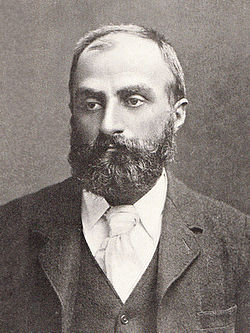
William Speirs Bruce FRSE (1 August 1867 – 28 October 1921) was a British naturalist, polar scientist and oceanographer who organised and led the Scottish National Antarctic Expedition (SNAE, 1902–04) to the South Orkney Islands and the Weddell Sea. Among other achievements, the expedition established the first permanent weather station in Antarctica. Bruce later founded the Scottish Oceanographical Laboratory in Edinburgh, but his plans for a transcontinental Antarctic march via the South Pole were abandoned because of lack of public and financial support.
In 1892 Bruce gave up his medical studies at the University of Edinburgh and joined the Dundee Whaling Expedition to Antarctica as a scientific assistant. This was followed by Arctic voyages to Novaya Zemlya, Spitsbergen and Franz Josef Land. In 1899 Bruce, by then Britain's most experienced polar scientist, applied for a post on Robert Falcon Scott's Discovery Expedition, but delays over this appointment and clashes with Royal Geographical Society (RGS) president Sir Clements Markham led him instead to organise his own expedition, and earned him the permanent enmity of the geographical establishment in London. Although Bruce received various awards for his polar work, including an honorary doctorate from the University of Aberdeen, neither he nor any of his SNAE colleagues were recommended by the RGS for the prestigious Polar Medal. (Full article...) -
Image 4
Willem Barentsz (Dutch pronunciation: [ˈʋɪləm ˈbaːrənts]; c. 1550 – 20 June 1597), anglicized as William Barents or Barentz, was a Dutch navigator, cartographer, and Arctic explorer.
Barentsz went on three expeditions to the far north in search for a Northeast passage. He reached as far as Novaya Zemlya and the Kara Sea in his first two voyages, but was turned back on both occasions by ice. During a third expedition, the crew discovered Spitsbergen and Bear Island, but subsequently became stranded on Novaya Zemlya for almost a year. Barentsz died on the return voyage in 1597. (Full article...) -
Image 5
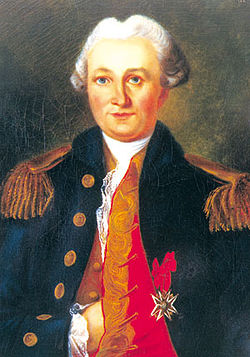
Counter-Admiral Yves Joseph Marie de Kerguelen-Trémarec (13 February 1734 – 3 March 1797) was a French Navy officer. He discovered the Kerguelen Islands in 1772 during his first expedition to the southern Indian Ocean. Welcomed as a hero after his voyage and first discovery, Kerguelen fell out of favour after his second voyage and was cashiered in 1775 for violating Navy regulations. He was rehabilitated during the French Revolution. Kerguelen authored books about expeditions and about French naval battles of the American Revolutionary War. (Full article...) -
Image 6
Fridtjof Wedel-Jarlsberg Nansen (Norwegian: [ˈfrɪ̂tːjɔf ˈnɑ̀nsn̩]; 10 October 1861 – 13 May 1930) was a Norwegian polymath and Nobel Peace Prize laureate. He gained prominence at various points in his life as an explorer, scientist, diplomat, humanitarian and co-founded the Fatherland League.
He led the team that made the first crossing of the Greenland interior in 1888, traversing the island on cross-country skis. He won international fame after reaching a record northern latitude of 86°14′ during his Fram expedition of 1893–1896. Although he retired from exploration after his return to Norway, his techniques of polar travel and his innovations in equipment and clothing influenced a generation of subsequent Arctic and Antarctic expeditions. He was elected an International Member of the American Philosophical Society in 1897. (Full article...) -
Image 7
Jean-Baptiste Étienne Auguste Charcot, better known in France as Commandant Charcot, (15 July 1867 in Neuilly-sur-Seine near Paris – 16 September 1936 at sea (30 miles north-west of Reykjavik, Iceland), was a French scientist, medical doctor and polar scientist. His father was the neurologist Jean-Martin Charcot (1825–1893).
As a sportsman, he was French rugby XV champion in 1896 and also won a double silver medal in sailing at the 1900 Summer Olympics. (Full article...) -
Image 8
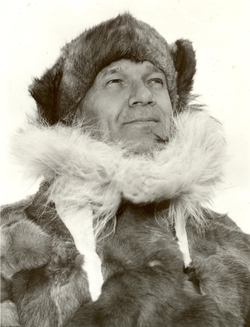
Finn Ronne (December 20, 1899 – January 12, 1980) was a Norwegian-born U.S. citizen and Antarctic explorer. (Full article...) -
Image 9

Anachronistic engraving of Lozier
Jean-Baptiste Charles Bouvet de Lozier (14 January 1705 – 1786) was a French explorer and colonial administrator of the Mascarene Islands to the east of Madagascar.
He was orphaned at the age of seven and after being educated in Paris, he was sent to Saint Malo to study navigation. He became a lieutenant of the French East India Company in 1731. He succeeded in convincing his employer to provide him with two ships and send him on an exploration mission in the South Atlantic. With his ships Aigle and Marie he discovered on 1 January 1739 a tiny island which was named Bouvet Island after him, the world’s remotest island; however, he mislabelled the coordinates for the island, causing it to be lost until it was rediscovered seven decades later in 1808. Shortly afterwards, he had to abandon the expedition because most of his crew had fallen ill; his ship then called at the Cape of Good Hope and returned to France. (Full article...) -
Image 10
Admiral Sir Richard Collinson KCB (7 November 1811 – 13 September 1883) was an English naval officer and explorer of the Northwest Passage. (Full article...) -
Image 11Ashley Chadbourne McKinley (June 23, 1896 – February 11, 1970) was an accomplished American aerial photographer and colonel in the U.S. Army Air Corps who helped pioneer aviation at subzero temperatures. He accompanied Richard E. Byrd as an aerial photographer on his expedition to the South Pole. (Full article...)
-
Image 12

A portrait of Dmitry Ovtsyn by N. V. Pinegin
Dmitry Leontiyevich Ovtsyn (Russian: Дмитрий Леонтьевич Овцын) (unknown - after 1757) was a Russian hydrographer and Arctic explorer. The Ovtsyn family is one of the oldest Russian noble families, originating from the descendants of Rurik, the Murom princes. (Full article...) -
Image 13

Bank of Russia 2001 coin
Fedot Alekseyevich Popov (Russian: Федот Алексеевич Попов, also Fedot Alekseyev, Russian: Федот Алексеев; nickname Kholmogorian, Russian: Холмогорец, for his place of birth (Kholmogory), date of birth unknown, died between 1648 and 1654) was a Russian explorer who organized the first European expedition through the Bering Strait.
He was normally known as Fedot Alekseyev. Only a few sources call him the son of Popov. He was from Kholmogory and the agent of Alexey Usov who was a member of the Gostinaya Sotnya, the highest merchant guild in Moscow. (Some time between 1647 and 1653 Usov petitioned to have Fedot apprehended on the grounds that Usov had sent him to Siberia with 3,500 rubles worth of goods and he had not reported back for eight years.) He went to Siberia in 1639. Moving east, he was at Tyumen, Tobolsk, Tomsk, Yeniseisk (1641) and Yakutsk(1642). In 1642 he joined a group of about 100 men under Ivan Rebrov who went down the Lena to the sea and up the Olenyok River to the west. Fedot had 29 men under him. Two years later they were defeated by the local Tungus and fled down the river. Fedot and some of his companions sailed east to the Kolyma River. (Full article...) -
Image 14
Admiral Alexander Vasilyevich Kolchak (Russian: Алекса́ндр Васи́льевич Колча́к; 16 November [O.S. 4 November] 1874 – 7 February 1920) was a Russian navy officer and polar explorer who led the White movement in the Russian Civil War. As he assumed the title of Supreme Ruler of Russia in 1918, Kolchak headed a military dictatorship, which ruled over the territory of the former Russian Empire controlled by the Whites. He was a proponent of Russian nationalism and militarism, while he opposed democracy as a principle which he believed to be tied to pacifism, internationalism, and socialism. As the principal leader of the White movement, he was one of the key architects of the White Terror.
Kolchak served in the Imperial Russian Navy and fought in the Russo-Japanese War and World War I. The son of a naval artillery officer, Kolchak graduated from the Naval Cadet Corps and went on to become an accomplished oceanographer and Arctic explorer. He was involved in several expeditions to northern Russia, including the New Siberian Islands, and became the youngest vice admiral in the Imperial Navy. He was wounded and taken prisoner during the Russo-Japanese War at the siege of Port Arthur, and upon his return he advocated for strengthening the fleet to the State Duma, including with the introduction of submarines and aircraft. Kolchak was the Baltic Fleet chief of operations when World War I broke out and was made the commander of the Black Sea Fleet shortly before the February Revolution. When Emperor Nicholas II asked the commanders of each army group and fleet for their opinion on abdicating the throne, Kolchak was the only one who opposed his abdication. (Full article...) -
Image 15
Georgy Alexeyevich Ushakov (Russian: Георгий Алексеевич Ушаков) (17 (30) January 1901 – 3 December 1963) was a Soviet explorer of the Arctic.
Ushakov broke new ground when he surveyed and explored Severnaya Zemlya, together with four other Arctic explorers, establishing that it was an archipelago. He was honoured by being named Doctor of Geographic Sciences in 1950. (Full article...) -
Image 16Matisen in Royal Navy uniform, 1900
Fyodor Andreyevich Matisen or Mathiesen (Russian: Фёдор Андреевич Матисен; 1 June [O.S. 20 May] 1872, – 19 December 1921) was an officer of the Russian Imperial Navy, hydrographer, and explorer.
Matisen explored and mapped wide areas of the coast of the Kara Sea and the Laptev Sea in the Russian Arctic. He was a friend of Alexander Kolchak and a member of the Russian Geographical Society and the Russian Academy of Sciences. (Full article...) -
Image 17

James Marr at Base A, Port Lockroy, 5 Nov 1944, during Operation Tabarin
James William Slessor Marr (9 December 1902 – 30 April 1965) was a Scottish marine biologist and polar explorer. He was leader of the World War II British Antarctic Expedition Operation Tabarin during its first year, 1943–1945. (Full article...) -
Image 18Jonas Poole (bap. 1566 – 1612) was an early 17th-century English explorer and sealer, and was significant in the history of whaling. (Full article...)
-
Image 19
Henryk Bronisław Arctowski (15 July 1871 – 21 February 1958; Polish pronunciation: [ˈxɛnrɨk art͡sˈtɔfskʲi]), born Henryk Artzt, was a Polish scientist and explorer.
Living in exile for a large part of his life, Arctowski was educated in Belgium and France. He was one of the first humans to winter in Antarctica, as part of the Belgian Antarctic Expedition, and became an internationally renowned meteorologist, also working for over 10 years in the United States. Arctowski was instrumental in restoring Polish independence after the First World War, after which he returned to Poland, where he continued a prolific academic career, having even declined an offer to become Minister of Education. At the time World War II broke out, Arctowski and his wife were in America, and they were unable to return; he spent the final part of his career working as a researcher at the Smithsonian until his retirement, and died in 1958 in Bethesda, Maryland. (Full article...) -
Image 20

The Arctic and Antarctic Research Institute, or AARI (Russian: Арктический и антарктический научно-исследовательский институт, romanized: Arkticheskiy i antarkticheskiy nauchno-issledovatelskiy institut, abbreviated as ААНИИ) is the oldest and largest Russian research institute in the field of comprehensive studies of Arctic and Antarctica. It is located in Saint Petersburg and is subordinated to the Federal Service for Hydrometeorology and Environmental Monitoring.
The AARI has numerous departments, such as those of oceanography, glaciology, meteorology, hydrology or Arctic river mouths and water resources, geophysics, polar geography, and others. It also has a computer center, ice research laboratory, experimental workshops, and a museum (the Arctic and Antarctic Museum). (Full article...) -
Image 21
Vilhjalmur Stefansson (November 3, 1879 – August 26, 1962) was an Arctic explorer and ethnologist. He was born in Manitoba, Canada. (Full article...) -
Image 22
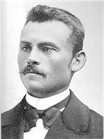
Helmer Julius Hanssen (24 September 1870 – 2 August 1956) was a Norwegian sailor, pilot and polar explorer. He participated in three of the polar expeditions led by Roald Amundsen and was one of the first five explorers to reach the South Pole. (Full article...) -
Image 23

Vice-Admiral Sir George Strong Nares KCB FRS (24 April 1831 – 15 January 1915) was a Royal Navy officer and Arctic explorer. He commanded the Challenger Expedition, and the British Arctic Expedition. He was highly thought of as a leader and scientific explorer. In later life he worked for the Board of Trade and as Acting Conservator of the River Mersey. (Full article...) -
Image 24
Nils Otto Gustaf Nordenskjöld (6 December 1869 – 2 June 1928) was a Swedish geologist, geographer, and polar explorer. (Full article...) -
Image 25

Location of Yana Bay in northern Siberia, on whose frozen surface Yakov Permyakov was murdered
Yakov Permyakov (Russian: Яков Пермяков; died 1712) was a Russian seafarer, explorer, merchant, and Cossack.
In 1710, while sailing from the Lena River to the Kolyma River, Permyakov observed the silhouette of two unknown island groups in the sea. Those islands would later be named Bolshoy Lyakhovsky and the Medvyezhi Islands. (Full article...)
Need help?
Do you have a question about Polar exploration that you can't find the answer to?
Consider asking it at the Wikipedia reference desk.
Subtopics
Associated Wikimedia
The following Wikimedia Foundation sister projects provide more on this subject:
-
Commons
Free media repository -
Wikibooks
Free textbooks and manuals -
Wikidata
Free knowledge base -
Wikinews
Free-content news -
Wikiquote
Collection of quotations -
Wikisource
Free-content library -
Wikiversity
Free learning tools -
Wiktionary
Dictionary and thesaurus
- What are portals?
- List of portals



